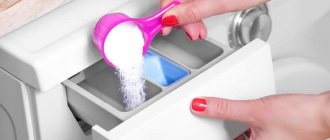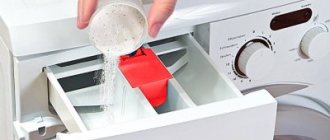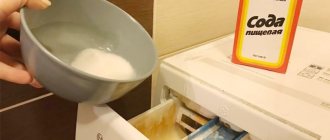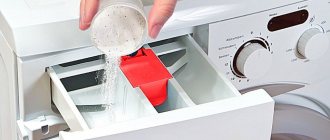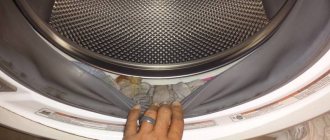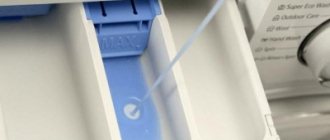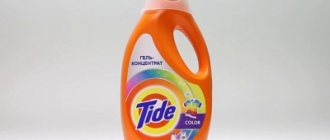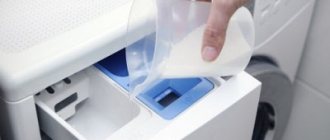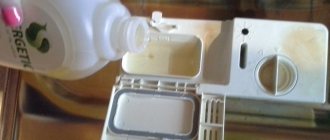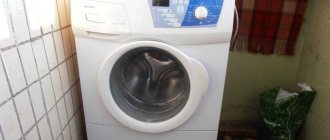Now, in addition to the usual dry washing powder, alternative substances have appeared on the laundry detergent market. These include liquid or gel forms. Compared to the traditional version, they have several undeniable advantages: they wash better, are more economical and do not leave stains on clothes. But some housewives prefer to use traditional powders. The explanation is that they do not know how to use washing gel correctly.
All about liquid detergents
Liquid powder is a detergent presented in gel form.
As a rule, the products are well concentrated and more economical in consumption, giving freshness and softness to the laundry. Also suitable for frequent washing to remove stains from delicate fabrics. But gels are not always able to cope with old and greasy stains. Perfectly suitable for washing in an automatic machine, subject to the pouring rules. Some users use it for washing dishes and glass.
Most housewives still hesitate to switch to concentrates because they do not know about their operating rules and properties. In fact, they are quite convenient to use. The only important point is that you need to know where the liquid powder is poured into the washing machine.
The most suitable temperature range is 30-40°C. Pours into the drum with dirty clothes or into the powder receptacle. Manufacturers recommend placing non-viscous liquid in a special compartment, and more viscous liquid in a drum with things. This is due to the fact that too thick products from the compartments cannot be washed off with water.
What is liquid powder
The name “liquid laundry detergent” refers to gel substances used to remove dirt. On sale, this drug is found in the form of capsules, which dissolve when water is added, or in the form of a thick liquid poured into plastic containers. The product has a high concentration of detergents, so its consumption during washing is minimal.
Features of composition, varieties and use
Compared to traditional loose laundry detergent, the liquid preparation has several advantages:
- eliminates all kinds of dirty marks;
- is easily removed from fabric fibers;
- completely dissolves in water of any temperature;
- after it no streaks appear on the fabric;
- takes care of the color of the fabric;
- makes matter softer;
- it is convenient to store, it does not spill, does not seize in lumps;
- can be applied in different ways.
The main disadvantages of this form of detergent preparations are:
- high price of the product;
- impossibility of setting a high water temperature for washing.
Gel products are an excellent option if you need to refresh your clothes with daily washing. They are also used if you need to wash things made of thin, delicate fabric. But such a product is not able to cope with old dirt and complex stains.
Types of liquid products
Such products are produced in special capsules and bottles. The first option is very convenient in terms of dosage - the liquid is already packaged in portions in sachets, which dissolve when washed.
They look like small pads of different shapes and colors. They are simply placed in the drum before the procedure itself.
Bottled concentrates are a classic option. Most have a measuring cap. Nowadays, for convenience, double lids with internal cream are made. Using this technology, the substance flows back into the container and does not spread over the outer surface and floor.
In non-food stores you can find a variety of colors of concentrates. They come in blue, pink, orange, green. In general, the list is quite extensive.
This does not affect the washing performance in any way, but it does affect the emotional perception of the product. Such a step is just a marketing ploy.
The following types of products exist:
- universal – used for any type of fabric and color;
- highly specialized - suitable for specific materials, for example, silk or wool;
- products divided by color - separately for colored, white or black;
- hypoallergenic;
- additional – stain removers, oxygen bleaches.
Use according to the washing machine instructions. There is often information about how much and where to fill.
Advantages and disadvantages
Manufacturers identify a number of advantages of gels over conventional powders.
Among the positive aspects of use:
- dissolve faster and, accordingly, penetrate faster into the fabric fibers;
- do not leave white streaks;
- act softer and more carefully, without destroying the fibers and without stripping the color;
- better rinsed out of linen and things;
- washes out of the compartment well;
- more environmentally friendly in composition and less likely to cause allergies;
- do not generate dust and do not have a strong odor, this is especially true for users who have the machine installed in the kitchen;
- reliable in storage;
- economical in spending.
The disadvantages of the detergent product include:
- the price is much higher;
- some old stains cannot be removed;
- used at temperatures not higher than 60 degrees;
- do not serve as a replacement for powder;
- spilled product cannot be collected, unlike traditional powder;
- Not all machines have special compartments.
Where to pour the concentrate
The loading location, as stated above, depends on its consistency. The capsules are placed in the drum, and then the laundry is added. The very concentrated gel is poured in the reverse order.
First, measure the dosage of the detergent using a dispenser cap. Then they load things in and pour in the gel. It is more advisable to load less concentrated products into a special tray.
Each washing machine has a powder receptacle with three divisions:
- The first compartment on the left is designated “A” or the number 1. Designed for soaking. The product is added there in rare cases; in some machines it is not allowed at all by the design of the compartment. Concentrates are loaded here in case of pre-wash.
- The second compartment is designated “B” or the number 2. It is intended for the main wash. This is the largest compartment of the three - it is into it that liquid powders are loaded.
- The third compartment is used for rinsing agents, conditioners, and antistatic agents. This is the smallest department of all. Indicated by a “C”, number 3, asterisk or other symbol.
As noted above, when using gels in the washing machine, the powder compartment for the conditioner remains empty. The designation of the compartments may differ depending on the brand of the automatic machine. Modern models already have a dedicated compartment for such gels.
Here the machine itself determines the dosage of consumables. As a result, the number of compartments in modern models is already four. Collection and consumption occurs automatically, taking into account the loaded laundry.
Not every concentrate can be added to the laundry drum. It is only poured into the compartment. It is necessary to study the information on product labels.
If the manufacturer does not allow loading the gel into the tray, and there is no special container, you should use dissolving capsules or balls.
The latter are filled with a substance, which is gradually released during the washing process and absorbed into the fabric. Often such balls are used for washing outerwear, in particular down jackets. They prevent the filler from clumping and provide gentle care.
How to use it correctly?
It remains to figure out how to properly use the gel-like “powder”. Many housewives usually use many times more gel than necessary. Because of this, the detergent quickly runs out, and the service life of the clothes gradually decreases. Despite the fact that the manufacturer always leaves instructions for use on such household chemicals, including dosage, it is not always necessary to adhere to these rules. It is better to follow the recommendations in the instructions for the washing unit than for the powder. To get the most out of your liquid detergent, follow the rules below.
- For a standard washing machine, designed to wash five or six kilograms of laundry, one tablespoon of gel-like “powder” is enough. If necessary, the dosage can be increased to two spoons if the items are heavily soiled and did not wash off on the first try.
- Washing gels give a positive result at water temperatures up to sixty degrees, so the unit must be run exclusively on the appropriate program. In hotter water, dirt remains on clothes.
- Under no circumstances should liquid “powder” be poured into the special compartment and drum of the washing machine at the same time. An overdose of the product can have a bad effect on clothing and the unit itself.
- The described gel washes things unevenly if the machine is overloaded, so if you have a large amount of dirty laundry, it is better to run the wash several times than once and with poor quality.
- Capsules with liquid “powder” can only be placed in the drum of a washing machine.
- If you need to skip the soaking step, simply treat the contaminated area with gel and wait from twenty to sixty minutes. Afterwards, wash the item as usual without using any detergents.
Despite the fact that liquid “powders” are very effective, they are not capable of working miracles, and this is worth remembering. Such products will not be able to remove old grease stains, as well as traces of paint, so in such cases you should not expect a positive result from them. At the same time, try to choose gels with a special purpose. For example, to treat black fabrics, purchase a product marked “Black”. In addition, there are powders intended for washing colored fabrics, as well as delicates, etc. The most popular companies producing the products described are Prox and Persil.
Terms of use
When loading the substance, you should adhere to the following recommendations:
- capsules are placed only in the drum;
- loading the gel is carried out according to the instructions of the washing machine, and not according to the recommendations indicated on the product label;
- after pouring, the required temperature regime is selected, but not higher than 60 degrees;
- The detergent is not loaded into several cells at once;
- is not added simultaneously to the compartment and to the drum;
- is not placed in the rinse aid compartment - the automatic machine begins to use the contents only at the rinsing stage.
For severe stains, you can do without pre-soaking. To do this, liquid powder is applied directly to the stain. After 15-20 minutes, wash the item in the machine, adding concentrate.
In many cases, product labels may overstate the dosage slightly. There is no need to use large amounts of detergent. For a washing machine with a load of up to 6 kg, only 2 tbsp is enough. gel.
Problems with liquid powder washing out of the tray
Water enters the compartment of the washing machine with liquid powder through a special guide. If a breakdown occurs in this place, the leaching of the liquid product is poor. Modern machines are equipped with solenoid valves that control the flow of water. The failure of one of them affects the entire water supply system. Sometimes the reason for poor leaching of the detergent is low pressure in the water supply. Then the problem will be solved by increasing the pressure in communications.
Important! You can determine the exact cause by pulling out the detergent tray and visually assessing the quality of the water supply.
If the gel is not completely washed out, then the problem is in the pressure. In this case, to eliminate it, you need to contact the management company or the housing office so that a booster pump can be installed in the apartment to increase the pressure. If you cannot hear the sound of water in the detergent compartment, then the cause is a broken valve. In this case, the device requires repair. It may involve changing the valve or control module.
